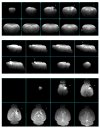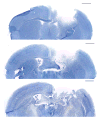A mouse model of sensorimotor controlled cortical impact: characterization using longitudinal magnetic resonance imaging, behavioral assessments and histology
- PMID: 17049995
- PMCID: PMC1941707
- DOI: 10.1016/j.jneumeth.2006.09.007
A mouse model of sensorimotor controlled cortical impact: characterization using longitudinal magnetic resonance imaging, behavioral assessments and histology
Abstract
The present study establishes a new mouse model for traumatic brain injury (TBI), using an electromechanically driven linear motor impactor device to deliver a lateral controlled cortical impact (CCI) injury to the sensorimotor cortex. Lesion cavity size was measured, and inter-animal consistency demonstrated, at 14 days post injury. Qualitative information regarding damage progression over time was obtained by scanning with high field magnetic resonance imaging (MRI) at five time points following injury. Functional impairment and recovery were measured with the Rotarod, gridwalk and cylinder tests, and lesion cavity volume was measured post mortem with thionin-stained tissue sections. The study establishes the reliability of a linear-motor based device for producing repeatable damage in a CCI model, demonstrates the power of longitudinal MRI in studying damage evolution, and confirms that a simple battery of functional tests record sensorimotor impairment and recovery.
Figures









References
-
- Baskin YK, Dietrich WD, Green EJ. Two effective behavioral tasks for evaluating sensorimotor dysfunction following traumatic brain injury in mice. J Neurosci Methods. 2003;129:87–93. - PubMed
-
- Bilgen M. Simple, low-cost multipurpose RF coil for MR microscopy at 9.4 T. Magn Reson Med. 2004;52:937–940. - PubMed
-
- Bilgen M. A new device for experimental modeling of central nervous system injuries. Neurorehabil Neural Repair. 2005;19:219–226. - PubMed
-
- Dash PK, Moore AN, Moody MR, Treadwell R, Felix JL, Clifton GL. Post-trauma administration of caffeine plus ethanol reduces contusion volume and improves working memory in rats. J Neurotrauma. 2004;21:1573–1583. - PubMed
Publication types
MeSH terms
Grants and funding
LinkOut - more resources
Full Text Sources
Other Literature Sources
Medical

